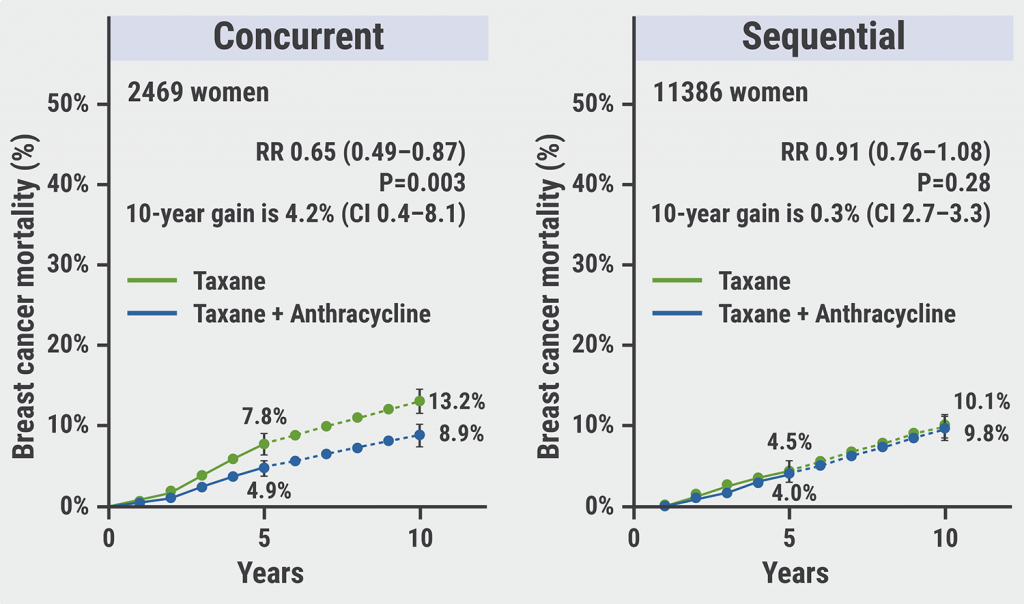https://doi.org/10.55788/b136268f
An elevated number of CTCs (≥5/7.5 mL) is an adverse prognostic factor for progression-free survival (PFS) and overall survival (OS) in patients with metastatic breast cancer [1]. The phase 3, randomised STIC CTC trial (NCT01710605), run before the introduction of CDK4/6 inhibitors for HR-positive/HER2-negative metastatic breast cancer, showed that CTC count was non-inferior to the clinician’s choice – with respect to PFS – to guide first-line treatment selection between chemotherapy and endocrine therapy [2]. Prof. François-Clément Bidard (Institut Curie, France) presented the OS data of the STIC CTC trial [3].
The trial enrolled 755 patients with HR-positive/HER2-negative metastatic breast cancer who could receive either endocrine therapy or chemotherapy as a first-line treatment, according to their physician. In all patients, a baseline CTC count was performed, before randomisation of the participants. Participants were randomised to treatment according to physicians’ choice (standard arm) or treatment based on CTC count (CTC arm: endocrine therapy if CTC <5/7.5 mL [CTC-low], chemotherapy if CTC ≥5/7.5 mL [CTC-high]). The median follow-up was 57 months.
In the standard arm, 272 participants with a clinically low-risk profile (Clin-low) were allocated to endocrine therapy and 103 participants with a clinically high-risk profile (Clin-high) to chemotherapy. In the CTC arm, 239 CTC-low participants were allocated to endocrine therapy and 138 CTC-high to chemotherapy. In 463 participants, treatment of physician’s choice was concordant with treatment based on CTC count (Clin-high/CTC-high, Clin-low/CTC-low). In 292 participants, there was discordance between physicians’ choice and treatment based on CTC count (n=189 Clin-low/CTC-high; n=103 Clin-high/CTC-low).
In participants with concordance between physician’s choice and CTC count-based therapy, there was no difference in the OS between the arms. However, participants with Clin-low/CTC-high treatment based on CTC count (chemotherapy) had a statistically significant and clinically meaningful survival benefit compared with treatment according to physician’s choice (endocrine therapy) with a median OS of 51.8 versus 35.4 months (HR 0.53; P=0.001). Therefore, in these patients, chemotherapy should be the treatment of first choice. In contrast, patients with Clin-high/CTC-low treatment based on CTC count did not have a different outcome compared with treatment based on physician’s choice. Therefore, in these patients, endocrine therapy should be the treatment of first choice.
Based on these results, Prof. Bidard concluded that “A single assessment of the CTC count before the start of treatment can guide the treatment decision between chemotherapy and single-agent endocrine therapy in HR-positive/HER2-negative metastatic breast cancer.”
- Bidard FC, et al. Lancet Oncol 2014; Lancet Oncol. 2014;15:406–414.
- Bidard FC, et al. JAMA Oncol. 2021;7:34–41.
- Bidard FC, et al. Circulating tumor cells-driven choice of first line therapy for HR+ HER2-metastatic breast cancer. Overall survival analysis of the phase 3 STIC CTC trial. Abstract GS3-09, SABCS 2022, 06–10 December, San Antonio, TX, USA.
Copyright ©2023 Medicom Medical Publishers
Posted on
Previous Article
« Germline pathogenic variants for breast cancer also increase contralateral breast cancer risk Next Article
Resistance to CDK4/6 inhibitors is likely due to expansion of pre-existing resistant clones »
« Germline pathogenic variants for breast cancer also increase contralateral breast cancer risk Next Article
Resistance to CDK4/6 inhibitors is likely due to expansion of pre-existing resistant clones »
Table of Contents: SABCS 2022
Featured articles
Miscellaneous
Racial disparity in the tumour microenvironment
Chemo-endocrine therapy worse for cognition than endocrine therapy alone
Early-Stage Breast Cancer
Anti-PD-1/anti-LAG-3 combination highly effective in HER2-negative breast cancer
MammaPrint test predictive for benefit of extended endocrine therapy
HR-positive/HER2-positive Breast Cancer: Trastuzumab-Deruxtecan
Trastuzumab deruxtecan effective in both second-line and neoadjuvant setting
HR-positive/HER2-negative Advanced Metastatic Breast Cancer
Benefit of adjuvant abemaciclib continues to deepen at longer follow-up
First-line ribociclib plus endocrine therapy outperforms combination chemotherapy
Treatment options beyond CDK4/6 inhibition
Triple-Negative Breast Cancer
Baseline CTC count can guide first-line treatment in HR-positive/HER-negative metastatic breast cancer
ZNF689 deficiency promotes intratumour heterogeneity and resistance to immune checkpoint blockade in TNBC
Oestradiol represses anti-tumoural immune response to promote progression of brain metastases
Basic and Translational Research
Resistance to CDK4/6 inhibitors is likely due to expansion of pre-existing resistant clones
Germline pathogenic variants for breast cancer also increase contralateral breast cancer risk
Low-dose tamoxifen still prevents recurrence from non-invasive breast cancer
Endocrine interruption to pursue pregnancy does not impact short-term disease in breast cancer
© 2024 Medicom Medical Publishers. All rights reserved. Terms and Conditions | Privacy Policy
HEAD OFFICE
Laarderhoogtweg 25
1101 EB Amsterdam
The Netherlands
T: +31 85 4012 560
E: publishers@medicom-publishers.com


